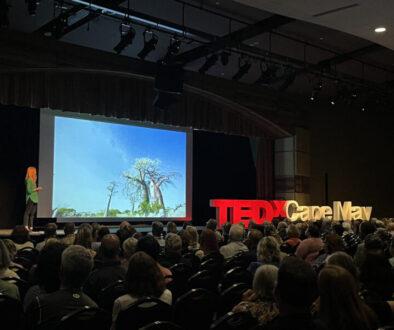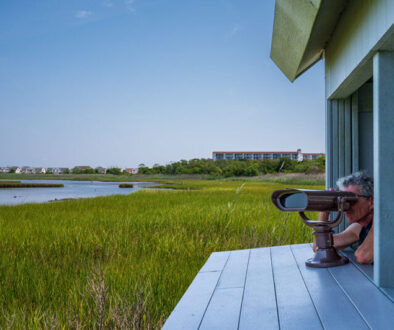The Mission Inn

It has always occurred to me that the moniker “Victorian Cape May” falls short. I don’t have anything against the architectural styles that the period encompasses—quite the opposite. Nevertheless, I feel it doesn’t capture our true value as a place of significant architecture. Cape May has a broader importance, one that extends into the 20th century.
The years bracketed by the death of Queen Victoria in 1901 and the onset of the Great Depression in 1929 was a time when American domestic architecture matured and reached its zenith. Revival styles, eclectic and backed by a scholarly approach, took root throughout the U.S., and especially in Cape May. The best-known revival styles include the Classical Revival, the Tudor Revival, and the Colonial Revival. They became a way to break the aesthetic constraints and even the mindset of the Victorian era and usher in a new century.


Inspired by the missions of California built under Spanish rule, the Mission Revival style is one of the most unique of the eclectic revival styles of the first decades of the 20th century. The Mission Inn, a fitting name for a large house on a supersized lot on New Jersey Avenue in “East Cape May,” is an outstanding embodiment of the Mission Revival style. Designed by architect Lloyd Titus of Philadelphia and built in 1912 for Nelson Z. Graves, the Mission Inn is somewhat of a departure from the expected.
Graves was a multi-facet businessman and possibly became enamored with the style as a result of the lead mines he owned in California. The Mission Inn’s form, layout, palette of earth tones, and use of materials—stucco, tile, and exposed decorative rafter tails—are key character-defining features of the Mission Revival style. Titus, by no means a stranger to Cape May, also designed a home for Peter Shields on Beach Avenue about five years earlier. His swing from the classically inspired Shields residence to the California-inspired Mission Inn is a testament to his stylistic range and his academic approach to revival designs. It is curious that Titus’s largest body of work is not residential; rather it consists of about two dozen public schools in Philadelphia. For them, Titus’s expressions included Romanesque Revival, Colonial Revival, and Late Gothic Revival.


Through the Cape May Real Estate Company founded in 1903, Shields and Graves played pivotal roles in the development of East Cape May, the area to the east of Madison Avenue. While Shields played a key role in the company initially, it was Graves who stepped in to keep the vision alive of East Cape May as a sought-after residential district and resort destination.
In 1910, he purchased the struggling Hotel Cape May (best remembered today as the Christian Admiral) and, in 1911, he acquired the real estate company. During the construction of the Mission Inn, however, Graves faced bankruptcy and never took up residency there. The quick turn of events in little more than a decade left their indelible mark on Cape May. The layout of rectangular, ample blocks with regular lot lines and the park running the length of Cape Avenue (features not found in the town’s 19th century core), as well as the numerous substantial homes are vestiges of this phase in Cape May’s history that we can recognize today.



The house is also the story of continued exemplary stewardship over multiple decades by different owners, many of whom were anchored in the visual and performing arts and all of whom appreciated the house’s uniqueness and sought to maintain its integrity.
Nina Scull, a painter and art educator, lived in the house between 1950 and 1979. With a penchant for generally engaging the public with the arts, Nina Scull was remembered as an institution at the time of her passing. Her home became a well-known place for painting lessons. She described her own painting as being in “no proscribed style,” and although she trained in the classical tradition, her work was often fluid and impressionistic.
The house’s living room, its central and most imposing room, has a 16-foot-high barrel-vaulted ceiling and a commanding brick fireplace which make it easy to envision as a salon. This word—appropriated from French that describes a place for social and intellectual gatherings—traces its popularity to Europe during late 19th and early 20th centuries where artists, academics, and philosophers interacted to exchange ideas.



Judy DeOrio and Diane Fisher purchased the house after the artist’s death. They were the first to adapt the house as a Bed and Breakfast in 1992, and they coined the Mission Inn name. Ms. DeOrio is recalled for her long involvement with Cape May’s Historic Preservation Commission, including as its chair, during the 1980s and 1990s. It was a time when the town’s understanding and appreciation of its architectural heritage became codified into law.
Ray and Susan Roberts bought the Mission Inn in 2002 and continued to operate it as a Bed and Breakfast. The Robertses made their own special imprint on the house that paid homage to its origins with numerous wall murals. Along with fanciful painted images of Spanish Colonial Missions and tropical settings, there are those that reflect Cape May, including the Christian Admiral, the Promenade Arches, and a likeness of Nelson Z. Graves.
Ownership of the inn was passed along to Wendy Collins and Laura Shaddock, who bought it from the Robertses in 2016. Over the next six years, which included a five-month closure due to COVID-19, they continued to revitalize the historic property.



The current chapter of the house’s history is being written by David Nevins and Catherine Moyal Nevins who purchased the house three years ago. They converted the house back into a private residence with several guest apartments to let. Catherine and David regard the Mission Inn’s style as romantic, something that drew them in from the start. “We felt an undeniable sense of belonging, even before stepping inside,” they explained. “Our mission is to be thoughtful stewards of this architectural treasure, honoring its legacy and the care of past owners by preserving and protecting it for future generations to experience and enjoy.”



